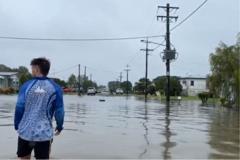Thousands of residents are returning home following catastrophic floods in Queensland, but recovery will be extensive due to significant damage. Experts warn that climate change is exacerbating extreme weather events.
Queensland Faces 'Incredible' Flood Devastation as Recovery Efforts Begin

Queensland Faces 'Incredible' Flood Devastation as Recovery Efforts Begin
The aftermath of severe flooding in northern Queensland highlights the urgent need for infrastructure improvements in climate-vulnerable regions.
Queensland communities are grappling with overwhelming destruction caused by severe flooding, as Premier David Crisafulli describes the situation as "incredible". Residents are beginning to return home after evacuations, although many properties and businesses are feared to be significantly damaged. Tragically, one woman's life was lost during the crisis. "This disaster is set to challenge our resilience," said Crisafulli during an interview with the ABC.
The region has received nearly 2 meters (6.5 feet) of rain since last weekend, triggering ongoing flood alerts and power outages, but Crisafulli noted that weather patterns had recently improved. Residents in Townsville awoke to drizzle and learned that previously feared flood levels had not materialized. "It appears the immediate danger has passed," assured Andrew Robinson, chair of the Townsville Local Disaster Management Group.
Local resident Jo Berry, who returned home after a harrowing night monitoring the storm, expressed both relief and trauma from previous flooding experiences, including the devastation of 2019 which resulted in over A$1 billion in damages. Reports indicate that many were anxiously monitoring their properties, worried about the potential flooding.
Further north, however, communities such as Ingham and Cardwell remain in turmoil, with widespread power outages complicating damage assessments. Crisafulli categorized the destruction as unprecedented, emphasizing Ingham as a major challenge due to its total loss of electricity. Residents faced long waits for essential supplies, illustrating the dire situation.
Additionally, the floods have taken a severe toll on local infrastructure, with over 8,000 properties lacking electricity. The collapse of key highways is significantly hindering relief efforts, prompting the government to collaborate with the army to deliver power generators to isolated areas. Crisafulli noted that federal funds will be allocated for rebuilding efforts, particularly on the critical Bruce Highway.
Experts warn that such extreme weather events will escalate due to climate change, urging officials to implement strategic planning that considers these shifting threats. Scott Heron, a climate expert from James Cook University, highlighted the necessity for future infrastructures to be fortified against potential weather-related challenges.
As recovery efforts continue, the broader impacts of climate change on Australian landscapes remain an urgent concern, with many calling for a reevaluation of policies to adapt to a changing climate. As Queensland braces for a long recovery, communities are determined to rebuild and enhance their resilience against future floods.






















